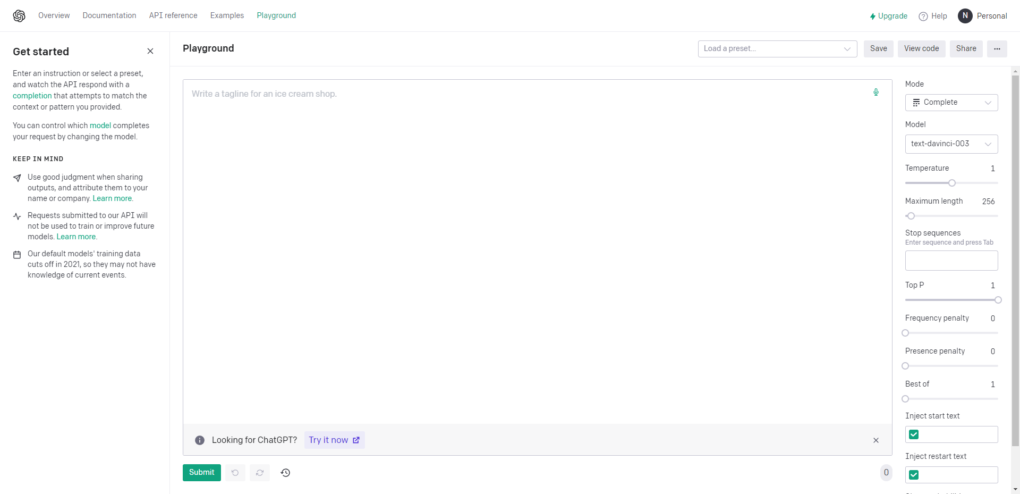With advancements in artificial intelligence (AI), conversations with machines are no longer limited to pre-programmed responses. The emergence of the ChatGPT Playground has revolutionized the way we interact with AI systems. This article delves into the potential of ChatGPT Playground, its applications, and the exciting future it holds for conversations and interactive AI.
What is ChatGPT Playground?
The ChatGPT Playground is an online platform provided by OpenAI that allows users to interact with ChatGPT, a large language model, in a conversational manner. It serves as a testing ground where users can ask questions, have discussions, and receive responses from the language model. The playground provides a text-based interface where users can input their queries and receive a generated text as a response. It’s designed to showcase the capabilities of the ChatGPT model and enable users to explore its potential applications.

What is ChatGPT?
ChatGPT is an interactive AI system developed by OpenAI. It is built upon the GPT (Generative Pre-trained Transformer) architecture, which allows it to generate human-like responses based on the input it receives. Unlike traditional chatbots, ChatGPT uses a deep learning model that enables it to understand and generate text in a more coherent and context-aware manner.
The growing demand for interactive AI
In today’s fast-paced digital world, users expect instant and personalized interactions. Businesses and individuals alike are seeking AI solutions that can provide efficient and engaging conversations. This increasing demand has led to the development of advanced conversational AI systems like ChatGPT.
Evolution of Conversational AI
Traditional chatbots and their limitations
Traditional chatbots relied on rule-based systems or simple keyword-matching techniques. While they served basic purposes, they lacked the ability to understand and respond to complex queries. The responses provided by these chatbots often felt robotic and failed to meet user expectations for natural and meaningful conversations.
Introduction of ChatGPT
ChatGPT introduced a new paradigm in conversational AI by leveraging the power of deep learning. Through extensive training on vast amounts of text data, ChatGPT can generate responses that are not only contextually relevant but also coherent and human-like. This breakthrough has significantly improved the quality of interactions with AI systems.
Advantages of ChatGPT over traditional chatbots
Compared to traditional chatbots, ChatGPT offers several advantages. It can understand a wide range of user inputs, adapt to different conversation styles, and provide responses that are more informative and contextually aware. Furthermore, ChatGPT’s ability to generate natural language makes interactions feel more human-like and engaging.
Understanding ChatGPT
How ChatGPT works
ChatGPT is based on a transformer model that uses attention mechanisms to process input text and generate responses. The model is trained on a diverse range of data sources, including books, articles, and websites. By learning patterns and structures from this data, ChatGPT can generate text that is coherent and contextually relevant.
The training process and data sources
During the training process, ChatGPT learns to predict the next word in a sentence based on the preceding context. This unsupervised learning approach allows the model to capture the nuances of language and generate coherent responses. The training data is carefully selected and preprocessed to ensure quality and minimize biases.
Continuous learning and improvement
ChatGPT is designed to continuously learn and improve over time. OpenAI periodically updates the model by fine-tuning it on specific tasks and incorporating user feedback. This iterative process helps ChatGPT enhance its capabilities and address any limitations or shortcomings identified during real-world usage.
Unveiling the Future of Conversations
Natural language understanding and generation
ChatGPT’s ability to understand and generate natural language is a crucial aspect of its future potential. As the model continues to evolve, it will become even more proficient in comprehending complex queries, understanding nuances, and generating human-like responses. This progress will unlock new possibilities for interactive AI in various domains.
Enhancing user experience with contextual understanding
One of the key advancements in ChatGPT is its contextual understanding. The model can maintain context over longer conversations, enabling more coherent and meaningful interactions. This contextual awareness opens doors to personalized and context-driven experiences, where AI systems can better assist users based on their specific needs and preferences.
Multimodal capabilities for richer interactions
The integration of multimodal capabilities into ChatGPT represents an exciting frontier in interactive AI. By combining text with other forms of media, such as images or videos, ChatGPT can provide more comprehensive responses and support a wider range of applications. This multimodal approach will enable users to engage with AI systems in more immersive and interactive ways.
Applications of ChatGPT
Customer support and chat assistance
ChatGPT has tremendous potential in the customer support industry. Its ability to understand and respond to customer queries in a personalized and efficient manner can greatly enhance the customer experience. ChatGPT can handle common support requests, provide relevant information, and even escalate complex issues to human agents when necessary.
Virtual companions and personal assistants
As ChatGPT becomes more conversational and context-aware, it can serve as a virtual companion or personal assistant. Users can engage in casual conversations, seek advice, get recommendations, or receive reminders and notifications. ChatGPT’s ability to understand user preferences and adapt to individual personalities will make these interactions more engaging and personalized.
Educational and language learning tools
ChatGPT can also play a significant role in education and language learning. It can provide explanations, answer questions, and offer guidance on various topics. By simulating conversations with a knowledgeable AI, students, and language learners can practice their skills, receive feedback, and gain a deeper understanding of the subject matter.
Ethical Considerations
Privacy and data security
Privacy and data security are important considerations when deploying AI systems like ChatGPT. It is crucial to handle user data responsibly, ensuring proper anonymization and encryption. OpenAI is committed to protecting user privacy and takes measures to minimize data retention and prevent unauthorized access to sensitive information.
Bias and Fairness in AI Systems
AI systems are susceptible to biases present in the training data. OpenAI acknowledges this challenge and strives to address biases in ChatGPT’s responses. Ongoing research and development efforts focus on reducing both glaring and subtle biases to ensure fair and unbiased interactions with the system.
Responsible use of ChatGPT
Responsible use of ChatGPT is paramount to prevent the misuse or dissemination of harmful content. OpenAI encourages users and developers to adhere to ethical guidelines and actively monitor and moderate the output generated by the system. Balancing user control with AI autonomy is crucial to maintain a safe and positive user experience.
Challenges and Limitations
Handling ambiguous queries
While ChatGPT excels at generating responses, it can sometimes struggle with ambiguous or poorly defined queries. The system may provide plausible but incorrect or nonsensical answers. Addressing this challenge requires further advancements in natural language understanding and improved methods to clarify user intent.
Dealing with offensive or harmful content
AI systems like ChatGPT need robust mechanisms to identify and handle offensive or harmful content. OpenAI incorporates safety measures and content filtering to mitigate the risk of inappropriate responses. However, eliminating all potential risks remains a challenging task that requires ongoing improvements and user feedback.
Striking a balance between user control and AI autonomy
Finding the right balance between user control and AI autonomy is essential. While users want conversational AI systems to be proactive and intuitive, they also value their ability to guide the conversation and ensure the system respects their boundaries. Striking this balance involves refining user interfaces and providing clear options for users to control the level of AI engagement.
Conclusion
In conclusion, the inclusion of ChatGPT Playground represents a significant leap forward in the field of conversational AI. With its remarkable capability to generate coherent, contextually relevant, and human-like responses, ChatGPT Playground opens up exciting new possibilities for interactive AI systems. As ChatGPT Playground continues to advance and improve, its applications in areas such as customer support, virtual companionship, education, and beyond will play a pivotal role in shaping the future of conversational AI.
Read also : Luna Crypto: A Game-Changing Investment Opportunity You Can’t Miss




